With the prospect of having parties once more now on the horizon perhaps you're looking for a way to make sure yours are going to be the talk of the town? If you have a Sonos system, a Sonos Port or Connect, a PC and the Philips Hue lighting system in your home, here’s one way of guaranteeing your friends and family will be talking about your parties for some time:
This is a guide on how to use a Port/Connect and a PC/laptop to link your Sonos system and your Philips Hue system together so that you can have your Hue lights react to the music playing on Sonos.
This method does require the Hue Bridge v2 device but does not require the Philips Hue HDMI Sync box.
If you don’t have a Connect or Port, but do have a first-generation Play:5, you could use the headphone socket on it and a 3.5mm to 3.5mm lead. The volume control for the Play:5 would come into play, however.
For now, instructions are for Microsoft Windows 10 and macOS but the troubleshooting/help steps in red are for Windows only. Steps on macOS will be along functionally similar lines.
Instructions
Steps to follow are in green. If you’re able to perform the step, go to the next green box.
If you’re unable to follow the step in the green box, or if something doesn’t work, help will be under a Show Content link. Click on Show Content to expand the help.
Hardware Setup
First, we need to connect the Port/Connect to your computer. To do this, you’ll typically need an RCA-3.5mm jack cable, or an RCA-RCA cable and an RCA to 3.5mm adaptor (if you have a good sound card with extra connections on your computer, you may just need an RCA-RCA cable).
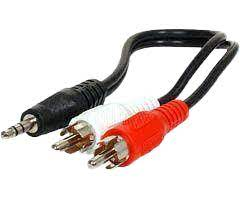
Connect the cable to the analogue RCA outputs on your Port/Connect. The other end of the cable should connect to the Line-In jack on your PC - typically in blue plastic as shown:
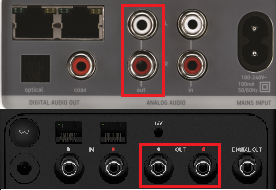

If your computer doesn’t have Line-In (typical on a laptop) you might be able to switch your microphone input (coloured red) into a Line-In using the software for your computer’s sound device (usually found in the System Tray at the bottom right corner of your Taskbar. This software may even pop up automatically when you plug something into the microphone or line-in jacks and ask you which type of device is connected).
Software Setup
With the hardware connected, we now need to get the Philips Hue Sync for PC desktop app installed. You might want to install the desktop Sonos app too, so you have full control on one device. Note that the Hue Sync app requires the Hue Bridge v2 device.
Link the Hue Sync app to your Hue lighting system. Philips have a video guide here.
If you have trouble linking the Hue app to your Hue lights, please visit Philips’ Hue Hardware FAQ page.
Once the Hue app is installed and linked to your Hue lights, we want to tell it which audio feed to listen to.
- Click on Settings
- Click Audio Preferences
- Under Audio device selection, click on the drop-down list and select your computer’s Line-In (or Microphone, if you’re using that) input.
- Exit the settings.
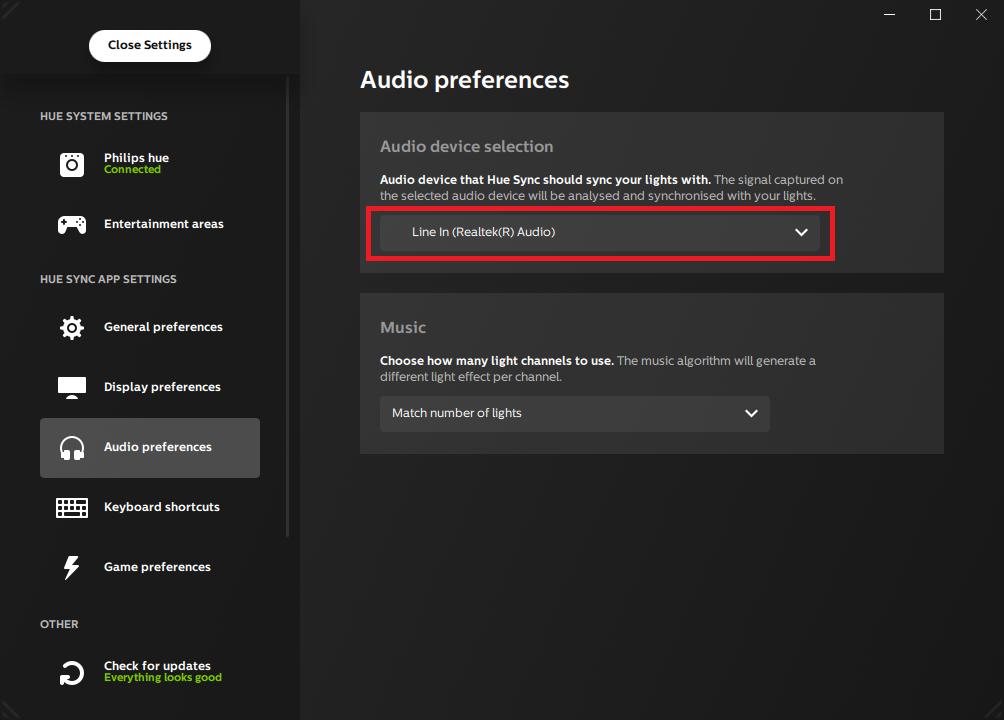
If you are unable to choose Line-In/Microphone because it’s not in the drop-down list, we’ll need to enable the input in Windows.
- Please right-click on your computer’s volume icon (bottom right corner of your screen) and click Open Sound settings.
- Scroll down to Input and select Line In under Choose your input device.
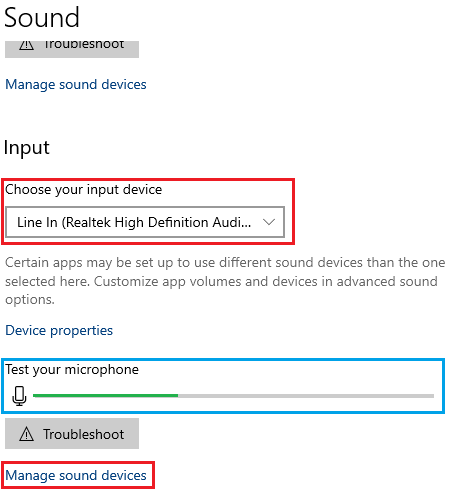
If it’s not available there either, click Manage sound devices, then Line-In under Input Devices and click Enable.
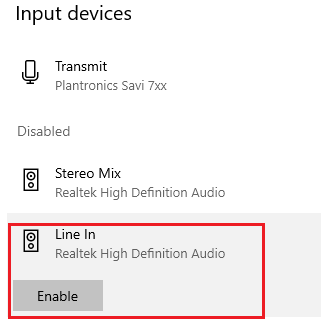
Go back to the first Sound Settings page and you should now be able to select Line-In as the input (though it will still not show if nothing is physically connected to the Line-In socket, so please double-check).
When Windows detects a signal, it fills the grey bar under “Test your microphone” in with green like a meter (as shown in the blue box in the first picture above) showing the input signal level.
With the correct input enabled and selected in Windows, you will now be able to select Line-In in the Hue app’s settings.
Play some music through Sonos speakers, and be sure to group the Connect/Port room in with it. Make sure it’s something that won’t stop playing while you’re testing, like radio, in case troubleshooting takes a while.
In the Hue app’s main window, you’ll see a place to choose which lights in your Hue system will be included. This is entirely up to you, but if you don’t select any, you won’t see anything happen (though the Hue app may change colours - this means it’s reacting to the input).
Select an Hue Entertainment Area to react to the music in the Hue app.
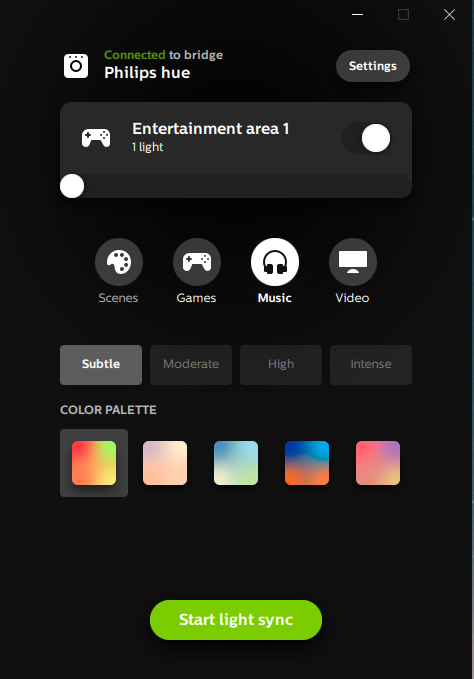
If you have no Entertainment Areas set up on your Hue system, you’ll need to set them up in the Hue smartphone app (not the Hue Sync app). You can have up to 10 lights in each area.
Below that, please select Music as the activity
Further down, you will see 4 settings for selecting Hue’s level of reaction to the music, and then some selections for the colour palette used. These can be chosen according to taste.
Click the green Start light sync button.
If all has gone well, your selected Hue lights will now react to the music playing over your Sonos system!
Testing
Do this at least a day before your party starts - give yourself time to figure things out if it doesn’t work straight away! Test your system beforehand every time you have an event - better safe than sorry!
Problems?
If Hue lights don’t react to the music:
- Please right-click on your computer’s volume icon (bottom right corner of your screen) and click Open Sound settings.
- Scroll down to Input and select Line In under Choose your input device.

When Windows detects a signal, it fills the grey bar under “Test your microphone” in with green like a meter (as shown in the blue box in the first picture above) reacting to the input signal level. If this is not happening, check the easy stuff first:
- Is Sonos still playing?
- Is the volume on the Port/Connect low? (we recommend Fixed output - see our No sound from Port or Connect page)
- Is the Port muted?
- Double-check which PC jack you’ve plugged into.
- Double-check which RCA connections you’ve used on Sonos.
- Try another audio cable (if it’s not new).
If the input you’re using is not available in the list shown in the picture above:
- Click Manage sound devices
- In the Input Devices section, under Line-In, click Enable.

Go back to the first Sound Settings page and you should now be able to select Line-In as the input (though it will still not show if nothing is physically connected to the Line-In socket).
If Windows displays the incoming signal (the green bar under Test your Microphone in Sound Settings) but the lights don’t react.
- Have you selected the correct input in the Hue app’s settings?
- Have you pressed the green Start Light Sync button?
- Have you selected some lights to react?
Additional Info
First, this article would not exist if not for the inspiration and assistance of community member
Many thanks
Our technical support agents are not trained in this. Individual agents may have the skills to be able to help you, but if you have trouble I recommend asking for help here on our Community Forum.
The Connect/Port Line-In connections are completely independent of Line-Out. Therefore, you can use Line-In from an external source on your Connect/Port while simultaneously feeding Hue with what it needs. You could therefore, for example, play a physical CD through your Sonos system via Line-In and use the same Connect/Port to make Hue react.
It may take a combination of varying the Hue sensitivity in the Hue app and the Line-In level on your computer to get the “perfect” reactions. I recommend keeping the Connect/Port Line-Out level at Fixed, to reduce the number of variables - see our Setup up your Sonos Port page.


